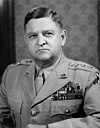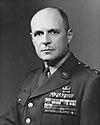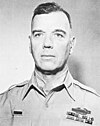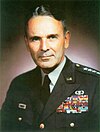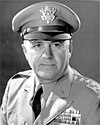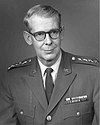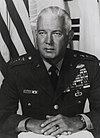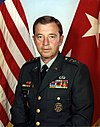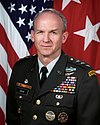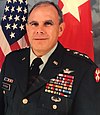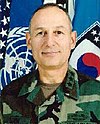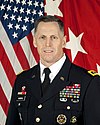Eighth Army (United States)
This article needs additional citations for verification. (April 2008) |
| Eighth Army | |
|---|---|
 Eighth Army Shoulder Sleeve Insignia | |
| Active | 10 June 1944 – present (79 years, 10 months) |
| Country | |
| Branch | |
| Type | Field army |
| Role | Headquarters |
| Part of | |
| Garrison/HQ | |
| Motto(s) | Pacific Victors |
| Colors | White and red |
| Campaigns | World War II |
| Insignia | |
| Distinctive insignia |  |
| Flag |  |
| NATO Map Symbol (1997) |  |
The Eighth Army is a U.S.
History
World War II
The unit first activated on 10 June 1944 in the United States, under the command of Lieutenant General
The Eighth Army again followed in the wake of the Sixth Army in December 1944, when it took over control of operations on
Occupation of Japan
Eighth Army was to have participated in
Korean War

The peace of occupied Japan was shattered in June 1950 when 75,000
The stalemate was broken by the

Both South and North Korea were almost entirely occupied by United Nations forces. However, once U.S. units neared the
General Ridgway forcefully restored Eighth Army to combat effectiveness over several months. Eighth Army slowed and ultimately halted the Chinese advance at the battles of
When General Ridgway replaced General of the Army Douglas MacArthur as the overall U.N. commander, Lieutenant General James Van Fleet assumed command of Eighth Army. After the war of movement during the first stages, the fighting in Korea settled down to a war of attrition. Ceasefire negotiations were begun at the village of Panmunjom in the summer of 1951, and they dragged on for two years. During the final combat operation of the war, Lieutenant General Maxwell D. Taylor (promoted to general 23 June 1953) commanded the Eighth Army. When the Military Demarcation Line was finally agreed to by the Korean Armistice Agreement, South Korea and North Korea continued on as separate states.
Guarding Korea

During the
This left the 2nd Infantry Division at the
Structure 1989

At the end of the Cold War Eighth Army consisted of the following units:
 Eighth Army, Yongsan Garrison, South Korea[17]
Eighth Army, Yongsan Garrison, South Korea[17]
- Headquarters & Headquarters Company
 2nd Infantry Division, Camp Casey[17]
2nd Infantry Division, Camp Casey[17] 17th Aviation Brigade, Camp Coiner[17][18][19]
17th Aviation Brigade, Camp Coiner[17][18][19]
- Headquarters & Headquarters Company
- 4th Battalion, 58th Aviation (Air Traffic Control), Camp Coiner[19]
- 1st Battalion, 501st Aviation (Assault), Camp Coiner (UH-60A Black Hawk helicopters)[19][20]
- 2nd Battalion, 501st Aviation (Medium Lift), Camp Coiner (CH-47D Chinook helicopters)[19][21]
- 4th Battalion, 501st Aviation (Attack), Camp Page (AH-1F Cobra & OH-58C Kiowa helicopters)[19]
- 5th Battalion, 501st Aviation (Attack), Camp Coiner (AH-1F Cobra & OH-58C Kiowa helicopters)[19]
 1st Signal Brigade, Camp Humphreys[22]
1st Signal Brigade, Camp Humphreys[22]
 8th Military Police Brigade (Provisional), Camp Coiner[17]
8th Military Police Brigade (Provisional), Camp Coiner[17]
- Headquarters & Headquarters Company
- 94th Military Police Battalion[27]
- 728th Military Police Battalion[28]
 501st Military Intelligence Brigade (Provisional), Yongsan Garrison[29]
501st Military Intelligence Brigade (Provisional), Yongsan Garrison[29]
- Headquarters & Headquarters Detachment
- 3rd Military Intelligence Battalion (Aerial Exploitation), Camp Humphreys[19]
- 524th Military Intelligence Battalion (Human Intelligence)[30]
- 532nd Military Intelligence Battalion (Intelligence & Electronic Warfare)[31]
- 751st Military Intelligence Battalion (Counterintelligence), Camp Humphreys[19]
 18th Medical Command, Seoul[17][19] (the following peacetime listing is incomplete)
18th Medical Command, Seoul[17][19] (the following peacetime listing is incomplete)
- Headquarters and Headquarters Detachment
- 52nd Medical Battalion[19]
- 121st Combat Support Hospital, Camp Humphreys
 19th Support Command, Daegu[17] (the following peacetime listing is incomplete)
19th Support Command, Daegu[17] (the following peacetime listing is incomplete)
- Headquarters and Headquarters Company
- Special Troops Battalion
- 20th Area Support Group, Camp Henry[17]
- Headquarters and Headquarters Company
- 23rd Area Support Group, Camp Humphreys[17][19]
- 25th Transportation Center (Movement Control), Yongsan Garrison
- 21st Transportation Company (Command Transport), Yongsan Garrison[33]
- 46th Transportation Company, Camp Carroll
- 34th Area Support Group, Seoul[17]
- Headquarters and Headquarters Company
- 501st Corps Support Group, Camp Red Cloud[17]
- Headquarters and Headquarters Company
- 8th Personnel Command[17][34]
- 516th Personnel Service Company[35]
- 175th Finance Center[17][36]
- 23rd Chemical Battalion[39]
- 44th Engineer Battalion (Combat) (Heavy), Camp Mercer
- 8th Army Band
Recent times
In 2003, plans were announced to move the 2nd Infantry Division southward. The division, with 15 bases north of the Han River and just south of the DMZ, was to be the most important formation to be moved south of the Han River in two phases "over the next few years" a joint statement between the South Korean and U.S. governments said on June 5, 2003.[40] As of 2015, it appears that one brigade of the 2nd Infantry Division will remain at Camp Casey, near Dongducheon.
The headquarters of the Eighth Army was Yongsan Garrison, but moved southward to Camp Humphreys by 2019.[2] In April 2017 the Eighth Army headquarters began its move from Yongsan to Camp Humphreys and held a ceremony to relocate a statue of General Walton Walker.[41]
Organization

- Eighth Army,
- Eighth Army Headquarters and Headquarters Battalion
- Headquarters Support Company
- Operations Company
- Intelligence and Sustainment Company
- Eighth Army Band
- South Korean Army)
- 2nd Infantry Division Combined Division Staff (Joint South Korean Army)
- Headquarters and Headquarters Battalion
- Rotational Stryker Brigade Combat Team
- 210th Field Artillery Brigade
- Headquarters and Headquarters Battery
- 210th Field Artillery Brigade Headquarters and Headquarters Battery
- 1st Battalion, 38th Field Artillery Regiment
- 6th Battalion, 37th Field Artillery Regiment
- Rotational M270 MLRSField Artillery Battalion
- 70th Brigade Support Battalion
- Combat Aviation Brigade, 2nd Infantry Division
- Headquarters and Headquarters Company
- 2nd Battalion (Assault), 2nd Aviation Regiment
- 3rd Battalion (General Support), 2nd Aviation Regiment
- 4th Battalion (Attack), 2nd Aviation Regiment
- 5th Squadron (Attack/Reconnaissance), 17th Cavalry Regiment
- Company E, 2nd Aviation Regiment (General Atomics MQ-1C Gray Eagle)
- 602d Aviation Support Battalion
- 2nd Infantry Division Sustainment Brigade
- Headquarters and Headquarters Company
- Special Troops Battalion
- 194th Combat Sustainment Support Battalion
- 2nd Infantry Division Combined Division Staff (Joint
- US Army Pacific
- Headquarters and Headquarters Company
- United States Army Communications Information Systems Activity, Pacific
- 41st Signal Battalion
- 304th Expeditionary Signal Battalion
- 19th Expeditionary Sustainment Command[44]
- Headquarters and Headquarters Company
- 94th Military Police Battalion
- Materiel Support Command Korea
- 6th Ordnance Battalion
- 25th Transportation Battalion
- 498th Combat Sustainment Support Battalion
- Korean Service Corps
- 35th Air Defense Artillery Brigade
- Headquarters and Headquarters Battery
- 2nd Battalion, 1st Air Defense Artillery Regiment (Patriot)
- 6th Battalion, 52nd Air Defense Artillery Regiment (Patriot)
- Battery D, 2nd Air Defense Artillery Regiment (THAAD)
- 65th Medical Brigade
- Headquarters and Headquarters Company
- 549th Hospital Center
- 168th Medical Battalion (Multifunctional)
- 618th Dental Company (Area Support)
- 106th Medical Detachment (Veterinary Service Support)
- 135th Forward Resuscitative Surgical Detachment
- 501st Military Intelligence Brigade
- Headquarters and Headquarters Company
- 3rd Military Intelligence Battalion
- US Army Reserve), at Parks Reserve Forces Training Area, California
- 524th Military Intelligence Battalion
- 532nd Military Intelligence Battalion
- 719th Military Intelligence Battalion
- United Nations Command Security Battalion, Joint Security Area
- Korean Field Office
- Army Special Operations Forces Liaison Element, Korea
- Joint United States Military Affairs Group - Korea
- Eighth Army Non-Commissioned Officers Academy
- Training Support Activity, Korea
- 11th Engineer Battalion, subordinate to US Army Pacific
- 23rd Chemical Battalion
- 4th Airfield Operations Battalion, 58th Aviation Regiment
- 2501st Digital Liaison Detachment - headquartered at Camp Yongin.[42] The detachment deploys in support of First (Wonju) and Third (Yongin) Republic of Korea Armies (FROKA/TROKA) and the soon to be Combined Ground Component Command (CGCC) to provide continuous liaison capability between Eighth Army and the two ROK Field Army headquarters.
- 2502nd Digital Liaison Detachment
- 3rd Battlefield Coordination Detachment
- United States Army Corps of Engineers, Far East District
- Eighth Army Headquarters and Headquarters Battalion
Other army units based in South Korea:
- 403rd Army Field Support Brigade, Camp Henry, part of Army Sustainment Command[45]
- Army Field Support Battalion - Korea
- Army Field Support Battalion - Northeast Asia
- 837th Transportation Battalion, part of 599th Transportation Brigade / Military Surface Deployment and Distribution Command
- United States Army Medical Materiel Agency - Korea
Specific units
8th Army Band
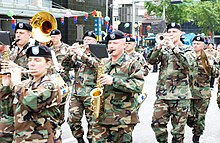
The 8th Army Band is the official musical unit of the HQ 8th Army and supports
Korean Service Corps
The Korean Service Corps was a reserve force composed of South Korean volunteers who were augmented to the 8th Army. They provided labourers who were used to carry ammunition and supplies, and support the overall logistic elements of the army. It is today, a paramilitary civilian formation that is battalion-sized. Continuing is role as a combat service support unit, it is capable of being expanded and mobilized during a wartime situation.
List of commanders
| No. | Commander | Term | |||
|---|---|---|---|---|---|
| Portrait | Name | Took office | Left office | Term length | |
| 1 | Lieutenant General Robert L. Eichelberger (1886–1961) | 1 June 1944 | 4 August 1948 | 4 years, 64 days | |
| 2 | Lieutenant General Walton Walker (1889–1950) | 4 August 1948 | 23 December 1950 | 2 years, 141 days | |
| 3 | Lieutenant General Matthew Ridgway (1895–1993) | 25 December 1950 | 12 April 1951 | 108 days | |
| 4 | General James Van Fleet (1892–1992) | 14 April 1951 | 11 February 1953 | 1 year, 303 days | |
| 5 | General Maxwell D. Taylor (1901–1987) | 11 February 1953 | 25 March 1955 | 2 years, 42 days | |
| 6 | General Lyman Lemnitzer (1899–1988) | 25 March 1955 | 5 June 1955 | 72 days | |
| 7 | General Isaac D. White (1901–1990) | 25 June 1955 | 1 July 1957 | 2 years, 6 days | |
| 8 | General George Decker (1902–1980) | 1 July 1957 | 30 June 1959 | 1 year, 364 days | |
| 9 | General Carter B. Magruder (1900–1988) | 1 July 1959 | 30 June 1961 | 1 year, 364 days | |
| 10 | 1 July 1961 | 31 July 1963 | 2 years, 30 days | ||
| 11 | 1 August 1963 | 15 June 1965 | 1 year, 318 days | ||
| 12 | General Dwight E. Beach (1908–2000) | 16 June 1965 | 31 August 1966 | 1 year, 76 days | |
| 13 | General Charles H. Bonesteel III (1909–1977) | 1 September 1966 | 30 September 1969 | 3 years, 29 days | |
| 14 | General John H. Michaelis (1912–1985) | 1 October 1969 | 31 August 1972 | 2 years, 335 days | |
| 15 | General Donald V. Bennett (1915–2005) | 1 September 1972 | 31 July 1973 | 333 days | |
| 16 | General Richard G. Stilwell (1917–1991) | 1 August 1973 | 8 October 1976 | 3 years, 68 days | |
| 17 | 8 October 1976 | 10 July 1979 | 2 years, 275 days | ||
| 18 | 10 July 1979 | 4 June 1982 | 2 years, 329 days | ||
| 19 | General Robert W. Sennewald (1929–2023) | 4 June 1982 | 1 June 1984 | 1 year, 363 days | |
| 20 | General William J. Livsey (1931–2016) | 1 June 1984 | 25 June 1987 | 3 years, 24 days | |
| 21 | General Louis C. Menetrey Jr. (1929–2009) | 25 June 1987 | 26 June 1990 | 3 years, 1 day | |
| 22 | General Robert W. RisCassi (born 1936) | 26 June 1990 | 1 December 1992 | 2 years, 158 days | |
| 23 | Lieutenant General William W. Crouch (born 1941) | 1 December 1992 | 18 October 1994 | 1 year, 321 days | |
| 24 | Lieutenant General Richard F. Timmons (born 1942) | 19 October 1994 | 31 July 1997 | 2 years, 285 days | |
| 25 | Lieutenant General Randolph W. House (born 1949) | 1 August 1997 | 25 September 1998 | 1 year, 55 days | |
| 26 | Lieutenant General Daniel J. Petrosky (born 1944) | 25 September 1998 | 28 September 2000 | 2 years, 3 days | |
| 27 | Lieutenant General Daniel R. Zanini (born 1946) | 28 September 2000 | 6 November 2002 | 2 years, 39 days | |
| 28 | Lieutenant General Charles C. Campbell (1948–2016) | 6 November 2002 | 10 April 2006 | 3 years, 155 days | |
| 29 | Lieutenant General David P. Valcourt (born 1951) | 11 April 2006 | 17 February 2008 | 1 year, 312 days | |
| 30 | Lieutenant General Joseph F. Fil Jr. (born 1953) | 18 February 2008 | 19 November 2010 | 2 years, 274 days | |
| 31 | Lieutenant General John D. Johnson (born 1952) | 9 November 2010 | 26 June 2013 | 2 years, 229 days | |
| 32 | Lieutenant General Bernard S. Champoux (born 1954) | 27 June 2013 | 2 February 2016 | 2 years, 220 days | |
| 33 | Lieutenant General Thomas S. Vandal (1960–2018) | 2 February 2016 | 5 January 2018 | 1 year, 337 days | |
| 34 | Lieutenant General Michael A. Bills (born 1958) | 5 January 2018 | 2 October 2020 | 2 years, 271 days | |
| 35 | Lieutenant General Willard Burleson (born 1965) | 2 October 2020 | 5 April 2024 | 3 years, 186 days | |
| 36 | Lieutenant General Christopher LaNeve | 5 April 2024 | Incumbent | 13 days | |
References
- ^ "Enter the Dragon: Eighth Army unveils new emblem" (15 April 2013)
- ^ a b Yongsan garrison move pushed back to 2019 Archived 30 June 2013 at the Wayback Machine
- ^ Eighth Army (12 February 2023). "History".
- ^ THEATER ARMY, CORPS, AND DIVISION OPERATIONS FM 3-94. United States Army. 2014. pp. 1–2.
- ^ MacArthur, Douglas (1966). Reports of General MacArthur: The Campaigns of MacArthur in the Pacific. Vol. I. Washington, DC: Center of Military History, United States Army. p. 423.
- ^ Reports of General MacArthur, p. 423.
- ^ Reports of General MacArthur, p. 450.
- ^ a b "Chronology of the Occupation: GHQ AFPAC; 15 August 1945 to 31 March 1946 Only". history.army.mil. Center of Military History, U.S. Army. Retrieved 13 February 2024.
- ^ United States Secretary of the Army (1949). Annual Report of the Secretary of the Army: 1948. Washington, DC: U.S. Government Printing Office. p. 65 – via Google Books.
- ^ Annual Report of the Secretary of the Army: 1948, p. 65.
- ^ National Archives, US Enters the Korean Conflict
- ^ History Vault Korean War
- ^ The National Defense Committee visits Eighth Army Headquarters (29 August 2017)
- ^ Don Oberdorfter, The Two Koreas: A Contemporary History, Addison-Wesley, 1997, p. 86.
- ^ Oberdorfer, The Two Koreas, 1997, 86-94.
- ISSN 0190-8286. Retrieved 20 March 2022.
- ^ a b c d e f g h i j k l Army - The Magazine of Landpower - January 1989 (1989). "Command and Staff". Association of the US Army. Retrieved 28 June 2020.
{{cite web}}: CS1 maint: numeric names: authors list (link) - ^ "17th Aviation Brigade Lineage". US Army Center of Military History. Retrieved 28 June 2020.
- ^ a b c d e f g h i j k l m n Colonel Johnnie L. Sheperd (1993). "Bring your Career to Korea!". US Army Aviation Digest - July / August 1993. Retrieved 28 June 2020.
- ^ "1st Battalion, 501st Aviation Lineage". US Army Center of Military History. Retrieved 28 June 2020.
- ^ "2nd Battalion, 501st Aviation Lineage". US Army Center of Military History. Retrieved 28 June 2020.
- ^ a b c d e Raines, Rebecca Robbins. "Signal Corps" (PDF). US Army Center of Military History. Retrieved 28 June 2020.
- ^ "36th Signal Battalion Lineage". US Army Center of Military History. Retrieved 28 June 2020.
- ^ "41st Signal Battalion Lineage". US Army Center of Military History. Retrieved 28 June 2020.
- ^ "304th Signal Battalion Lineage". US Army Center of Military History. Retrieved 28 June 2020.
- ^ "307th Signal Battalion Lineage". US Army Center of Military History. Retrieved 28 June 2020.
- ^ "94th Military Police Battalion Lineage". US Army Center of Military History. Retrieved 28 June 2020.
- ^ "728th Military Police Battalion Lineage". US Army Center of Military History. Retrieved 28 June 2020.
- ^ "501st Military Intelligence Brigade Lineage". US Army Center of Military History. Retrieved 28 June 2020.
- ^ "524th Military Intelligence Battalion Lineage". US Army Center of Military History. Retrieved 28 June 2020.
- ^ "532nd Military Intelligence Battalion Lineage". US Army Center of Military History. Retrieved 28 June 2020.
- ^ a b "3rd Battalion, 501st Aviation Lineage". US Army Center of Military History. Retrieved 28 June 2020.
- ^ "21st Transportation Company Lineage". US Army Center of Military History. Retrieved 28 June 2020.
- ^ "8th Personnel Center Lineage". US Army Center of Military History. Retrieved 28 June 2020.
- ^ "516th Personnel Service Battalion Lineage". US Army Center of Military History. Retrieved 28 June 2020.
- ^ "175th Financial Management Support Center Lineage". US Army Center of Military History. Retrieved 28 June 2020.
- ^ "176th Finance Company Lineage". US Army Center of Military History. Retrieved 28 June 2020.
- ^ "177th Finance Battalion Lineage". US Army Center of Military History. Retrieved 28 June 2020.
- ^ "23rd Chemical Battalion Lineage". US Army Center of Military History. Retrieved 28 June 2020.
- ^ Putnam, Bill (9 June 2003). "U.S. Forces Korea to start major realignment next year" (PDF). See page 9.
- ^ "8th U.S. Army Starts Moving Out of Seoul". The Chosun Ilbo. 26 April 2017. Retrieved 27 April 2017.
- ^ a b Eighth Army 2023b.
- ^ "The conventional military balance on the Korean peninsula" (PDF document) p.55
- ^ "Team". 19th Expeditionary Sustainment Command. Retrieved 19 April 2021.
- ^ "403rd Army Field Support Brigade (AFSB)". Army Sustainment Command. Retrieved 19 April 2021.
- ^ "Soldier Support Journal". 1982.
- ^ "EIGHTH ARMY BAND - History".
- ^ "Eighth Army Band - Eighth Army | The United States Army". 8tharmy.korea.army.mil. Retrieved 28 August 2022.
- ^ "8th Army band readies for Wonju festival".
- ^ "EIGHTH ARMY BAND - News".
- ^ "U.S. 8th Army Band's Ensemble Group, Alliance Brass Celebrates 99th Birthday in Mongolia". 30 June 2015.
- Blair, Clay (2003). The Forgotten War: America in Korea, 1950-1953 (illustrated, reprint ed.). Naval Institute Press. ISBN 1591140757. Retrieved 18 April 2014.
- Blair, Clay (12 December 1987). The forgotten war: America in Korea, 1950. Times Books. ISBN 0812916700. Retrieved 18 April 2014.
- Eighth Army (12 February 2023). "MSC Organization". US Eighth Army.
{{cite web}}: CS1 maint: date and year (link)
External links
- Eighth Army – Official Homepage
- GlobalSecurity: Eighth Army
- The short film STAFF FILM REPORT 66-12A (1966) is available for free viewing and download at the Internet Archive.


